Samsung Galaxy Note 10.1 (2014 Edition) Review
by Brian Klug & Anand Lal Shimpi on October 1, 2013 9:00 AM EST- Posted in
- Tablets
- Samsung
- Mobile
- Galaxy Note 10.1
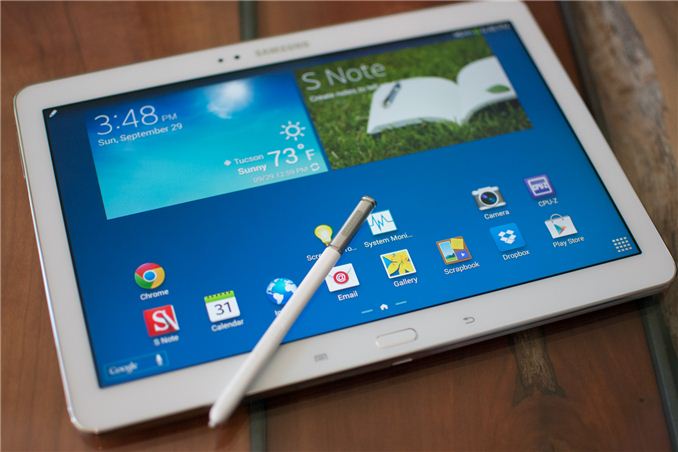
Ever since the arrival of the Nexus 10, it’s been hard recommending other, lower resolution 10-inch Android tablets. Although not the knock out success that the Nexus 7 became, the Nexus 10 did offer a good alternative to the iPad at a lower price. Given that Samsung made the aforementioned 10-inch Nexus, complete with 2560 x 1600 display, we wondered when a similar panel might grace Samsung’s own tablet lineup. A few weeks ago we got the answer we’ve been waiting almost a year for.
The latest iteration of Samsung’s Galaxy Note 10.1, aptly named the 2014 Edition, ships with the firm’s own 10.1-inch 2560 x 1600 display. It’s not display alone that Samsung hopes to sell its latest Note 10.1 on, the rest of the package is similarly specced to the max.
Unlike the Galaxy Note 3 where the majority of devices sold will likely use Qualcomm’s Snapdragon 800, the new Note 10.1 uses Samsung’s own Exynos 5420 SoC for all WiFi models. It’s only the LTE versions that will leverage Qualcomm silicon, but WiFi tablets still sell extremely well. All of this makes the 2014 Edition the first Samsung Android device to ship with its own Cortex A15 silicon in the US since the Nexus 10.
Add 3GB of RAM, tick the 802.11ac box and all you’re missing is USB 3.0 from the Galaxy Note 3. The result is Samsung’s first truly high end 10.1-inch Android tablet since the Nexus 10, and as its name implies, it comes with an S Pen. The entire bundle comes at a $150 premium to the much lower specced Galaxy Tab 3 10.1 and to the Galaxy Note 8.0:
| Specifications | |||||||||
| Samsung Galaxy Note 10.1 (2014 Edition) | Samsung Galaxy Tab 3 10.1 | Samsung Galaxy Note 8.0 | |||||||
| Dimensions | 243.1 x 171.4 x 7.9mm | 210.8 x 135.6 x 7.95mm | 210.8 x 135.6 x 7.95mm | ||||||
| Display | 10.1-inch 2560 x 1600 Super Clear LCD | 10.1-inch 1280 x 800 LCD | 8.0-inch 1280 x 800 LCD | ||||||
| Weight | 535g (WiFi) | 510g (WiFi) | 338g (WiFi) | ||||||
| Processor | 1.8GHz Samsung Exynos 5420 (4 x Cortex A15/4 x Cortex A7, Mali-T628MP6) |
1.6GHz Intel Atom Z2560 (2 x Atom , PowerVR SGX544MP2) |
1.6GHz Samsung Exynos 4412 (4 x Cortex A9, Mali 400MP4) |
||||||
| Connectivity | WiFi , Optional 3G/4G LTE | WiFi , Optional 3G/4G LTE | WiFi , Optional 3G/4G LTE | ||||||
| Memory | 3GB | 1GB | 2GB | ||||||
| Storage | 16GB—64GB + microSD | 16GB/32GB + microSD | 16GB/32GB + microSD | ||||||
| Battery | 31Wh | 25.84Wh | ~17Wh | ||||||
| Starting Price | $549 | $399 | $399 | ||||||
Design
Balancing a desire to make tons of sweet cash with criticisms about material quality, Samsung revamped its 2014 Note family with a new design. Rather than the smooth glossy plastic back we’ve seen with the previous generation of Notes, the Galaxy Note 10.1 2014 Edition inherits the same back cover finished in faux leather from the Galaxy Note 3.
I’ve already gone into detail on the improvement this is over the previous slick plastic in our Galaxy Note 3 review, but in short it’s a good step forward. There’s a difference in finish between the white and black versions (the latter has more of a grip laden rubbery texture), but both are better than the previous generation. We’re still talking about injection molded plastic and not real leather, but it’s a big step forward and honestly feels quite good in hand. The fake stitching is a bit much for me personally, though those looking for a more organic feel might appreciate it.
The new Note 10.1 maintains roughly the same dimensions as the new Galaxy Tab 3 10.1, although with far better internals and display.
The usual design staples are all here. There’s a microSD card slot on the right hand side as well as stowage for the new S Pen. Up top you’ll find the power/lock switch and volume rocker. There’s a physical home button front and center, flanked by capacitive menu and back buttons. The design is distinctly Samsung.
Software & OS
The 2014 Edition of the Galaxy Note ships with Android 4.3, as well as the typical set of S Pen, multi-window and other productivity enhancements you’d expect from a Samsung Note device. I’ve already gone through these in our Galaxy Note 3 review as well as in our Galaxy Note 8.0 review, so I’ll point you there for more details. In short, the S Pen is an interesting productivity addition to a tablet. It does a reasonable job of approximating a pen and paper experience, although understandably with more lag than you're used to (along with some other quirks).
CPU & Performance
The 5420 is Samsung’s second Exynos 5 Octa SoC, pairing a quad-core Cortex A15 cluster with a quad-core Cortex A7 cluster. The Note 10.1’s implementation still only supports cluster migration, with either the Cortex A15 or Cortex A7 cluster being active at once, effectively making the chip a quad-core SoC in the eyes of the user and OS. The point of having both A15 and A7 clusters on board is to be able to switch between the two depending on workload demands. If you need performance, a quad-core Cortex A15 is at your disposal, running at up to 1.8GHz (up from 1.6GHz in the previous Exynos 5410). If you need battery life however, the Cortex A7 cluster takes over running at up to 1.3GHz in the 5420 (up from 1.2GHz). Switching between the two is seamless as far as the OS is concerned, and for the first time the two clusters have a functioning cache coherent interconnect between the two (although it's not leveraged in the Note 10.1's implementation). Ideally Samsung’s implementation would go one step further and feature a cache shared between both clusters (rather than a 2MB L2 for the A15 cluster and 512KB L2 for the A7 cluster), but we’re still in the early days of big.LITTLE.
The 5420 performs understandably quite well. In lightly threaded tests the Note 10.1 pulls ahead of the old Nexus 10, but in those that exploit the tablet’s four A15 cores we see a significant jump forward. Samsung was able to deliver a relatively good experience with four Cortex A9 cores in their Galaxy Note 8, the new Note 10.1’s underlying hardware just does an even better job.
The four A15s are generally quicker then Qualcomm's Snapdragon 800/Krait 400s, but typically fall short of Intel's Atom Z3770 under Android as well as Apple's Cyclone cores in the A7.
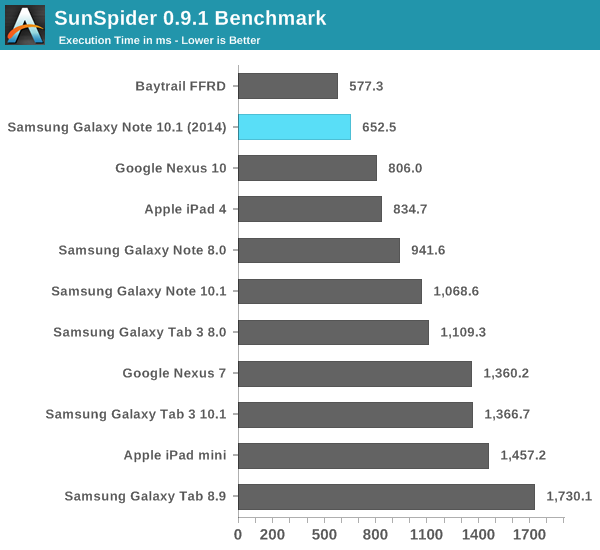
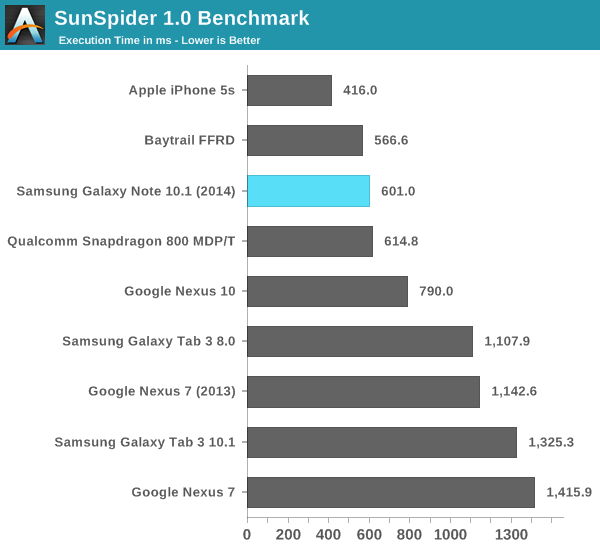
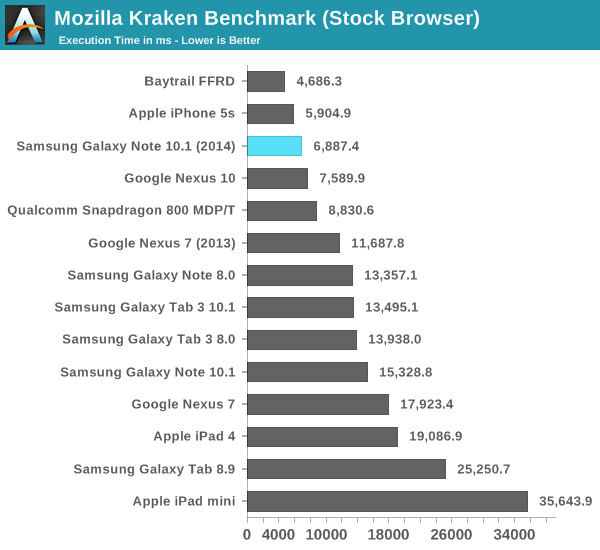
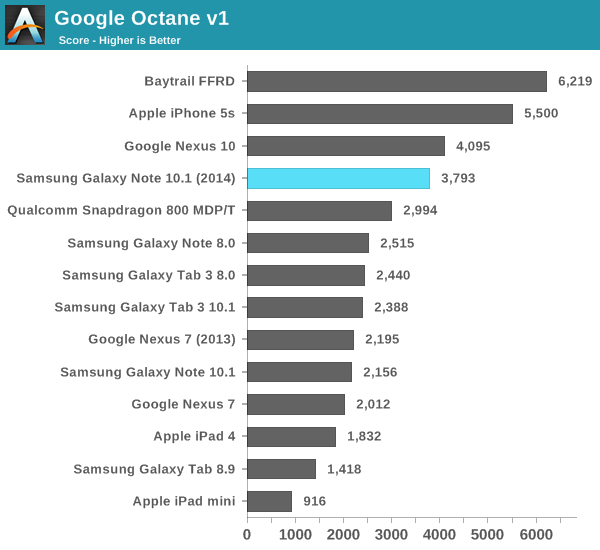
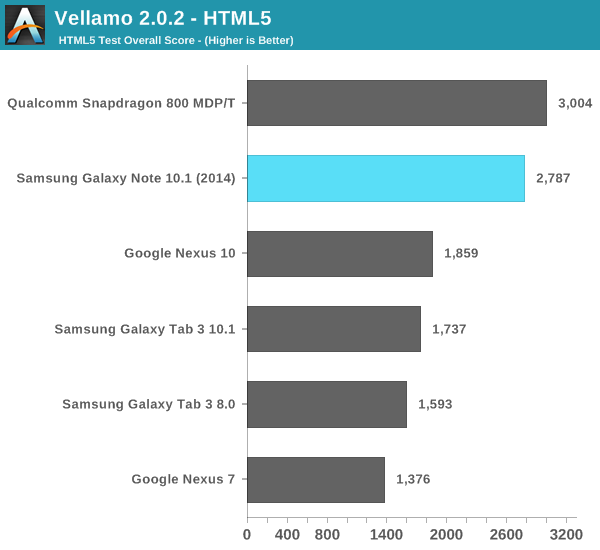



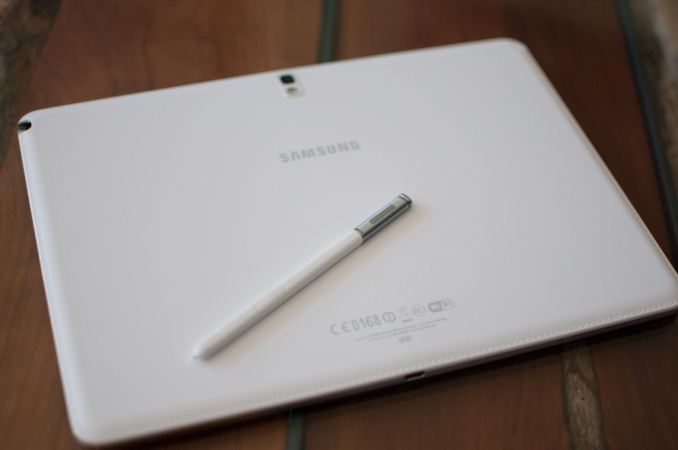
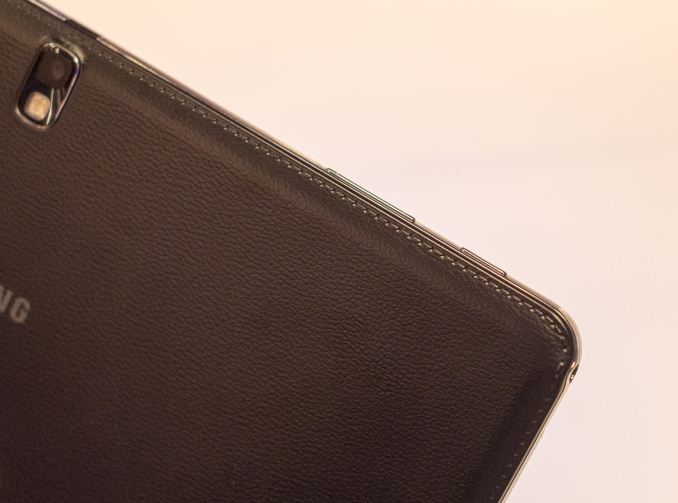








97 Comments
View All Comments
Diogenes5 - Tuesday, October 1, 2013 - link
So because of some arbitrary benchmark, you want to spend almost $400 dollars more on a device that will get even less support, has a worse resolution, and has even fewer dedicated apps?Ok fanboy, please leave the intelligent community at Anandtech alone and go back to the kiddie pool.
As always, Anandtech provides the best reviews. Looks like I'll be getting one write off the bat. As a student, I've been using last year's Note 10.1 as my daily driver along with LectureNotes and ezPDF. I could really use the upgrade in resolution and cpu/gpu in order to browse through my textbooks more quickly and precisely.
Da W - Tuesday, October 1, 2013 - link
"So because of some arbitrary benchmark, you want to spend almost $400 dollars more on a device that will get even less support, has a worse resolution, and has even fewer dedicated apps?"Looks like you are posting worst fanboy comments than me.
I just said the point that jumped in my face was how good the iPhone's 5s SoC was in the benchmarks, compared to a 10" tablet!
As for the other point, i used a tablet PC since 2000 something, and to that point the Surface Pro is the note-taking tablet perfected, WAY more useful for work or college work with a full office suite. I think MS has that niche covered better than Samsung. (price excluded, but a Baytrail surface pro would be perfect).
Impulses - Tuesday, October 1, 2013 - link
Bay Trail belongs on the regular Surface, and I imagine it'll show up as soon as they give up on RT... But other OEMs are soon gonna be seriously undercutting MS by offering Bay Trail on devices that are sold at the current price point of the original Tegra 3 Surface RT ($350, see ASUS), WITH keyboard dock even. Windows tablets would spread so much quicker if they'd just give up on RT already imo, and started pricing them appropriately (Pro's fine, but Surface's overpriced for what it is and what it's competing with).Da W - Tuesday, October 1, 2013 - link
RT is a long term plan to be platform agnostic. *IF* Windows 8.X sees enough success, *IF* enough developpers build Metro apps for it, *IF* office and other popular windows software are translated to Metro format and *IF* the convergence between widnows phone and windows 8 succeed, then in 2-3 years Microsoft will be free of intel and just pick whatever best SoC the market has to offer at that time. Which may or may not be Intel's.However, in order to do that, Microsoft had to push Windows RT to see widespread adoption, and they had to force Metro down a few peoples' troat in windows 8 desktop. In retrospect, may be they are failling, but they had no choice to do what they did in order to acheive their goal. Otherwise, if intel dies, they die. And yes when you look at the trend, ARM is picking up quickly and charging cheap.
Problem is: they have to improve Metro by a wide margin and open it up. Windows 8.1 is not nearly enough. Then developers need to adapt their software to it.
I'm surprised so few people picked that up.
Diogenes5 - Tuesday, October 1, 2013 - link
Baytrail runs Android just as well as Windows 8.1 if Intel marketing is to be believed. For platform agnostics, if a company can come out with a good baytrail tablet with an active stylus and dual boot with both Android and Windows, then count me in. I'll wait and see if that actually happens though.Diogenes5 - Tuesday, October 1, 2013 - link
Phones often beat tablets all the time. They all use the same SOC's for the most part. Samsung used basically the same Exnyos chips in its Galaxy Note II, Note 8.0 and Note 10.1 2013. Apple did the same with it's dated Ipad 2 chip when it released the Ipad Mini. Saying that the current Iphone 5s chip beats the Note 10.1 2014 really doesn't mean that much to most people. They are about the same speed and the Iphone 5s beats most other devices on the market right now.Congrats for using a tablet PC when Microsoft poorly underserved the market with its bulky form factors, bad battery life, and poor application support in the mid-2000's.
The surface Pro is indeed not perfect. The few people that I knew owned one complained that it ran hot, ran loud sometimes, and had only about 4-5 hour battery life even for in-class note-taking. It's nice that you get a full x86 chip but it also costs twice of what most Android and iOS tablets do. Maybe the Surface Pro 2 will improve upon some of these things. It will probably get about 20-30% more battery life and having a battery in the keyboard dock will help longevity. Unfortunately, 64gb of SSD space (about only half of which will be available) and only 4gb of ram for an OS with much more overhead than Android is not at all impressive for an $899 device.
I, for one, will happily use my galaxy Note 10.1 2014 in class just like I have with my Galaxy Note 10.1 2013 and sync my lecturenotes and pdf's to dropbox for later viewing on my other devices. At half the price and half the headache of a microsoft device.
ESC2000 - Thursday, October 10, 2013 - link
The benchmarks don't tell the full story though since they're running single threaded JS which doesn't allow the note to demonstrate its six-core advantage.djboxbaba - Tuesday, October 1, 2013 - link
"Apps" "Support". Really? surface PRO, aka the full windows environment. Please tell me when you can serious applications on the galaxy note.abazigal - Friday, October 11, 2013 - link
The fact that tablets (be it IOS or Android-based) get touch-optimised apps that were designed from the ground up already gives it the advantage compared to the Surface Pro, which has to contend with desktop apps wholly unsuited to a touch interface.All the computing power in the world means jack squat when your apps suck to use, which in turn ensures that nobody will use it.
eiriklf - Tuesday, October 1, 2013 - link
It says a lot more about safari compared to samsungs browser.